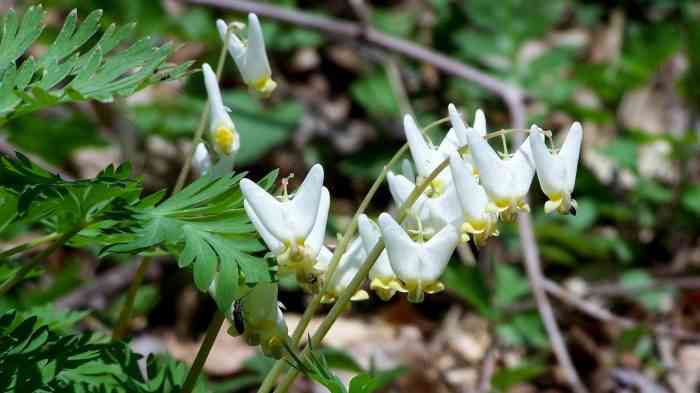Your cart is currently empty!
Dutchman’s Breeches is a Spring Nectar Source
Photo:
Cbaile19, CC0, via Wikimedia Commons
Dutchman’s Breeches is an ephemeral spring woodland species. It blooms in the early spring, when sunlight hits the forest floor before the canopy of trees fills in. The nectar on the blooms will be easily accessible to the first emerging bumblebees. The foliage, which resembles fern leaves, begins to yellow in early summer and eventually goes dormant by the middle of the season.
Appearance
Because the flowers resemble the pantaloons that Dutch men wore in the sixteenth and seventeenth centuries and were hung upside down on a clothesline, these plants are also known as Dutchman’s Breeches. Bumblebees are more likely to pollinate the blooms since they are able to fly at that time of year, early spring. Additionally, bumblebees are big and muscular enough to open the blossoms and get the pollen inside.
Quick Growing Guide

Botanical Name: Dicentra cucullaria
En français: Dicentre à capuchon
Colour:
Blooms:
Sun / Shade:
Water: Medium water requirement.
Soil:
Pollinators:
Care:

Growing
Between zones 3 and 8, Dutchman Breeches are hardy. They are early spring ephemerals that develop, bloom, and set seed before the trees have begun to leaf out. They require full sun to some shade to develop. Leaf litter is where they prefer to live. There won’t be any Dutchman’s Breeches sprouting in areas where the leaf litter has been removed.
Remember that this plant spreads quickly if it is put in the proper spot and grows from an underground tuber. Give it lots of space to spread, or be ready to dig up and transplant tubers in the winter.
When growing from seed, seed of this species are to be kept under refrigeration (33-38 F) until you are ready to plant or apply pre-sowing treatment.
Planting
Fall is the perfect time to plant breeches. What you will get when you buy them are corms. The tops of the corms should be planted one inch below the soil line. To avoid crowding, space them 6 inches apart when planting. Water them frequently. Early in the spring, around March, the leaves will start to emerge.
Where to Plant Dutchman’s Breeches
In nature, they are found in deciduous woods. Threfore, they are best naturalized in woodland, wildflower, or native plant gardens. It is best to plant them in a location with medium moisture, well-drained soil and clay, loam soils in part shade to full shade. It is intolerant of wet soils in winter. Generally, Dutchman’s Breeches are considered inappropriate for borders because the plants go dormant by summer.
Hostas and ferns are good companion plants.
Dutchman’s Breeches Care
In the wild, they are frequently discovered in wet, shady areas of rocky, slope woods. Once they have blossomed in the early spring, the plant will go dormant until the following year. The stems and leaves will then fall to the ground. They disappear, making room for other late-spring or summer blooms to take their place. They’re a fantastic choice for gardeners searching for a regularly flowering garden.
Soil for Dicentra cucullaria
Although Dutchman’s breeches may adapt to several soil types, the plant thrives in moist, rich in organic content, and well-draining soil. The weeks before the plant’s ephemeral bloom require plenty of moisture, but once the plant enters dormancy, drier soil is beneficial for Dutchman’s breeches.
Although it can thrive with a pH level that is more in the neutral range, the plant prefers an acidic soil mixture. For the following year, the most growth and flowers will result from that special combination.
Light
Dutchman’s breeches thrive in a shaded area of your yard and grow best when planted in either partial or full shade. These plants develop on the forest floor beneath a tree canopy in their natural habitat, where they only get filtered sunlight. Because of this, they are a fantastic choice for gardeners with many mature trees on their property or for people with shaded areas.
Temperature
Dutchman’s breeches plants should not require any particular temperature requirements or humidity levels as long as they are planted in the appropriate USDA hardiness zone. The plant needs a time of cold to germinate for the following spring, and when the soil has warmed to about 60 degrees Fahrenheit, you should see new plants emerge.
Watering Dutchman’s Breeches
It takes an average quantity of water for Dutchman’s breeches to flourish. It is often not essential to physically provide water in colder regions because the majority of this water is provided by snowmelt in the early spring.
A decent rule of thumb is to wait until the ground has dried just a little bit, but never totally, before watering the plant again if manual watering is required in your area. Every 10 to 14 days, a plant only requires about 1 cup of water. Once the plant has produced its spring bloom, you can stop watering it completely.
Pruning
The Dutchman’s breeches don’t need to be pruned. By the end of its growing season, they will naturally vanish, with the leaf coming back in the early spring.
You can pinch off or deadhead the spent blooms from the blooming stem. Cut off the flowering stem using pruning snips when the entire stalk of flowers has faded to urge the plant to focus its energy on reblooming rather than seed formation.
Fertilizer
Although fertilizing your Dutchman’s breeches is not necessary for its development, growing it in nutrient-rich soil has advantages. Before planting, enrich the soil with some organic matter if your area is lacking in nutrients.
Medicinal
This plant was valued by early white practitioners as well as Native Americans for treating syphilis, skin disorders, and blood purification. Dutchman’s breeches have a central nervous system-depressing alkaloid that is used to treat paralysis and tremors.
Share with Family and Friends
Featured Authors
Visit a Botanical Garden For Unique Experiences.
Comments
Logging in to comment gives you more features, but it is not required.
Subscribe
0 Comments
Oldest












